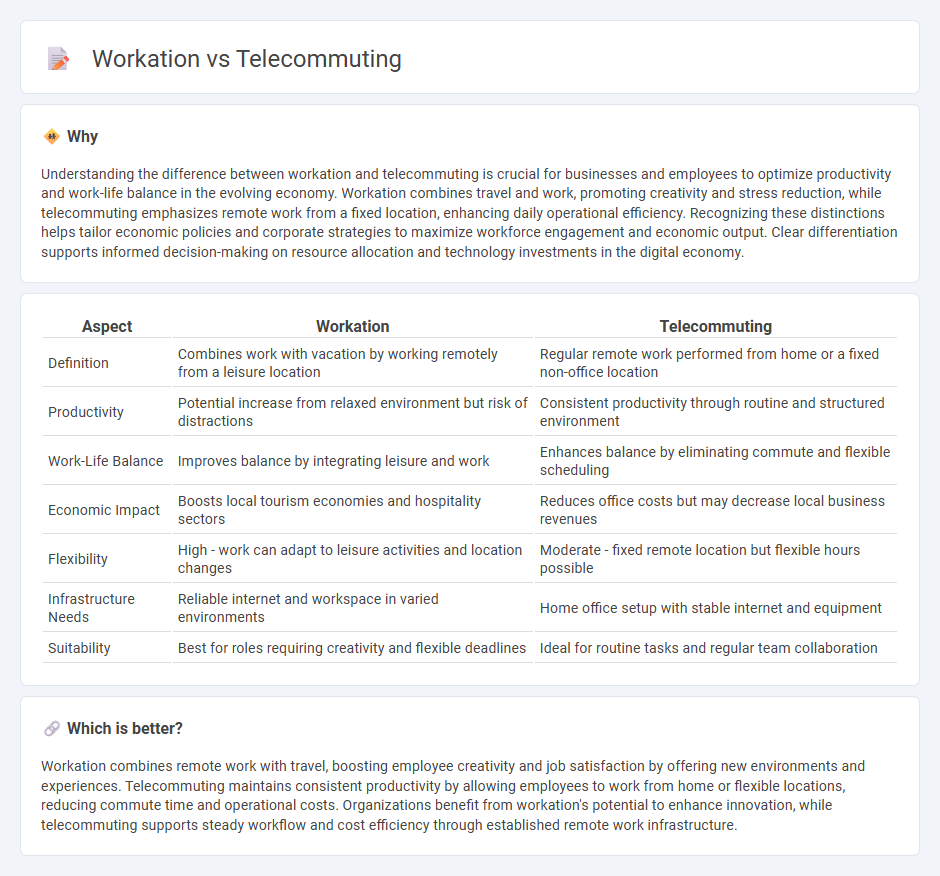
Workation combines remote work with travel, allowing employees to experience new environments while maintaining productivity. Telecommuting focuses solely on working remotely from a fixed location, often home, prioritizing convenience and work-life balance. Explore how these work models impact economic trends and workforce dynamics.
Why it is important
Understanding the difference between workation and telecommuting is crucial for businesses and employees to optimize productivity and work-life balance in the evolving economy. Workation combines travel and work, promoting creativity and stress reduction, while telecommuting emphasizes remote work from a fixed location, enhancing daily operational efficiency. Recognizing these distinctions helps tailor economic policies and corporate strategies to maximize workforce engagement and economic output. Clear differentiation supports informed decision-making on resource allocation and technology investments in the digital economy.
Comparison Table
| Aspect | Workation | Telecommuting |
|---|---|---|
| Definition | Combines work with vacation by working remotely from a leisure location | Regular remote work performed from home or a fixed non-office location |
| Productivity | Potential increase from relaxed environment but risk of distractions | Consistent productivity through routine and structured environment |
| Work-Life Balance | Improves balance by integrating leisure and work | Enhances balance by eliminating commute and flexible scheduling |
| Economic Impact | Boosts local tourism economies and hospitality sectors | Reduces office costs but may decrease local business revenues |
| Flexibility | High - work can adapt to leisure activities and location changes | Moderate - fixed remote location but flexible hours possible |
| Infrastructure Needs | Reliable internet and workspace in varied environments | Home office setup with stable internet and equipment |
| Suitability | Best for roles requiring creativity and flexible deadlines | Ideal for routine tasks and regular team collaboration |
Which is better?
Workation combines remote work with travel, boosting employee creativity and job satisfaction by offering new environments and experiences. Telecommuting maintains consistent productivity by allowing employees to work from home or flexible locations, reducing commute time and operational costs. Organizations benefit from workation's potential to enhance innovation, while telecommuting supports steady workflow and cost efficiency through established remote work infrastructure.
Connection
Workation and telecommuting both leverage remote work technologies to enhance employee productivity and work-life balance, contributing significantly to the gig and digital economies. The rise of high-speed internet and cloud computing enables professionals to perform tasks from diverse locations, supporting flexible work arrangements that reduce overhead costs for businesses. These trends stimulate economic activity by increasing demand in sectors such as travel, hospitality, telecommunications, and remote work software development.
Key Terms
Productivity
Telecommuting enhances productivity by enabling remote work with minimal distractions and flexible hours, leveraging technology to maintain consistent communication and workflow. Workation combines travel with work, offering a refreshing change of environment that can boost creativity but may introduce challenges in maintaining regular productivity levels due to potential distractions. Explore strategies to balance productivity effectively in both telecommuting and workation settings.
Remote work
Remote work encompasses telecommuting, where employees perform job duties from home using digital tools, and workation, which combines work with vacation in a different location. Telecommuting promotes productivity and work-life balance by eliminating daily commutes, while workation fosters creativity and reduces burnout through environmental change. Discover more about optimizing remote work strategies and their impact on employee well-being.
Cost savings
Telecommuting allows employees to save on daily commuting expenses, such as fuel and public transportation fees, while often enabling reduced spending on work-related attire and meals. Workations combine work and vacation, potentially increasing costs due to travel and accommodation expenses but offering tax deductions or employer reimbursements in some cases. Explore how balancing these factors can optimize your overall cost savings strategies.
Source and External Links
What Is Telecommuting in Today's Work Environment? - Telecommuting enables employees to work remotely using their own or company-provided devices and internet, connecting to company networks and conducting meetings via platforms like Zoom or Google Workspace.
What is telecommuting? | Definition from TechTarget - Telecommuting allows workers to complete their job from outside the traditional office, using telecommunications tools, and can be arranged full-time, part-time, temporarily, or as freelance work.
What is Telecommuting? Pros and Cons - Telecommuting is a flexible work arrangement where employees perform duties outside a conventional office, typically from home or a nearby location, communicating digitally with employers.
 dowidth.com
dowidth.com